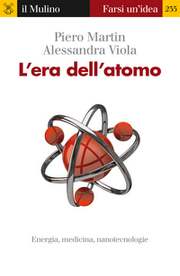 "The era of the atom" is a new book by Piero Martin and Alessandra Viola - for now the book is only printed in Italian (by Il Mulino), but I hope it will soon be translated in English. Piero Martin is a professor of Physics at the University of Padova and a member of the RFX collaboration, a big experiment which studies the confinement of plasma with the aim of constructing a fusion reactor (he is also in fact a member of ITER); and Alessandra Viola is a well-known journalist and writer of science popularization (among her books is "Brilliant green: the surprising history and science of plant intelligence", available here).
"The era of the atom" is a new book by Piero Martin and Alessandra Viola - for now the book is only printed in Italian (by Il Mulino), but I hope it will soon be translated in English. Piero Martin is a professor of Physics at the University of Padova and a member of the RFX collaboration, a big experiment which studies the confinement of plasma with the aim of constructing a fusion reactor (he is also in fact a member of ITER); and Alessandra Viola is a well-known journalist and writer of science popularization (among her books is "Brilliant green: the surprising history and science of plant intelligence", available here).  The book was presented yesterday at the Venice Museum of Natural History, thanks to the organization of Margherita Fusco and the director Luca Mizzan (here is the press release of the event). It took place in a conference room next to the big corridor where the skeleton of a big cetacean is hung from the ceiling (see picture, right).
The book was presented yesterday at the Venice Museum of Natural History, thanks to the organization of Margherita Fusco and the director Luca Mizzan (here is the press release of the event). It took place in a conference room next to the big corridor where the skeleton of a big cetacean is hung from the ceiling (see picture, right). In the corridor were placed several stands to complement the event with an exhibit. I participated with a stand with posters and videos on the LHC collider, the CMS experiment, and the Higgs boson discovery.
The presentation by Piero and Alessandra was lively and fun. They discussed how atomic physics became gradually a very important reality in everyday life in the course of the last century. The discussion ranged from uses of x-rays to fix bones but also to determine the proper fitting of shoes, to the discovery of atomic fission and the atomic bomb, to uses of radiocarbon dating to identify false paintings, to irradiation of crops to create more robust and productive strands, and the prospects to improve the productivity of food to face the challenge of feeding a 9-billion human being population in 2050.
 I knew the subject rather well, having discussed it at similar events as a speaker, but I still learned something from the discussion. For example, I was oblivious of the fact that fluoroscopes were used until 1970 by shoe retailers, to see the clients' feet within the shoes they were trying on. In the image on the right (credit: powerhousemuseum.com) you see the cavity where you would insert your foot; the clerk would observe the x-ray scan from the other side.
I knew the subject rather well, having discussed it at similar events as a speaker, but I still learned something from the discussion. For example, I was oblivious of the fact that fluoroscopes were used until 1970 by shoe retailers, to see the clients' feet within the shoes they were trying on. In the image on the right (credit: powerhousemuseum.com) you see the cavity where you would insert your foot; the clerk would observe the x-ray scan from the other side.The x-ray doses received by the involved persons - the client and the shoe shop clerk - were huge by todays' standards, due to the technology of x-ray production and shielding, but the machines were all the rage in the thirties in the US. It is hard to say how many people died from the resulting exposure, but it is probably a very significant number. A radiation dose map is available in this blog post.
Another "fun" fact which was discussed was the irradiation of grapefruit seeds with slow neutrons to stabilize the red colour of the "star ruby" variety, which had resulted from a spontaneous mutation in a Texas plant. After the presentation I raised my hand and posed the question: "I wonder whether when they sell those grapefruits they first remove the neutrons ?!" Everybody laughed at the absurdity of the concept, but indeed there are those who are scared by the idea of irradiating seeds, even if the fruit they eat comes from seeds that have been generated decades earlier.
But the stand was only one among many: there was one on nuclear fusion and the ITER project, another on the use of microwaves to "burn" tumors (the surgeon there had even a demonstrator which he used on a chicken breast to show the effect of the localized thermalization), a third on the use of nanoparticles in everyday products like sun screens or fake banknotes detection, and others.
I was pleased to get engaged, after the presentation of the book, by a crowd which posed me dozens of questions ranging from the Higgs boson to cosmic rays and antimatter, the universe, string theory and the multiverse, quantum gravity, and the like. I think I did a good job - my 16-year-old son was present and he is a tough judge, but he said he was entertained by the discussion.




Comments